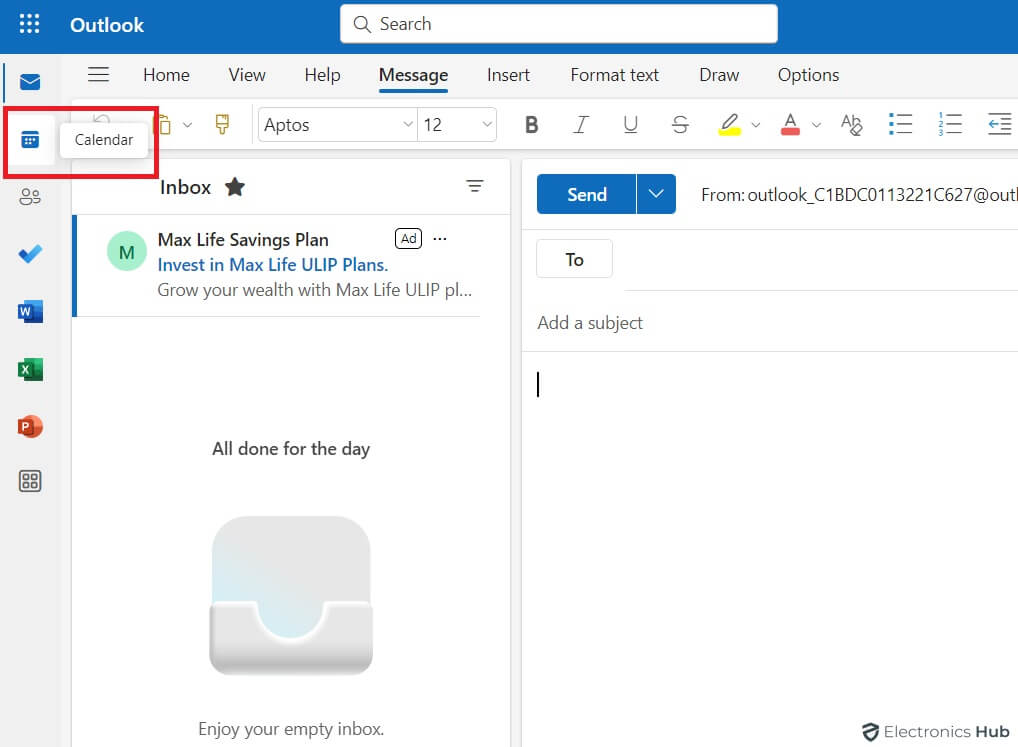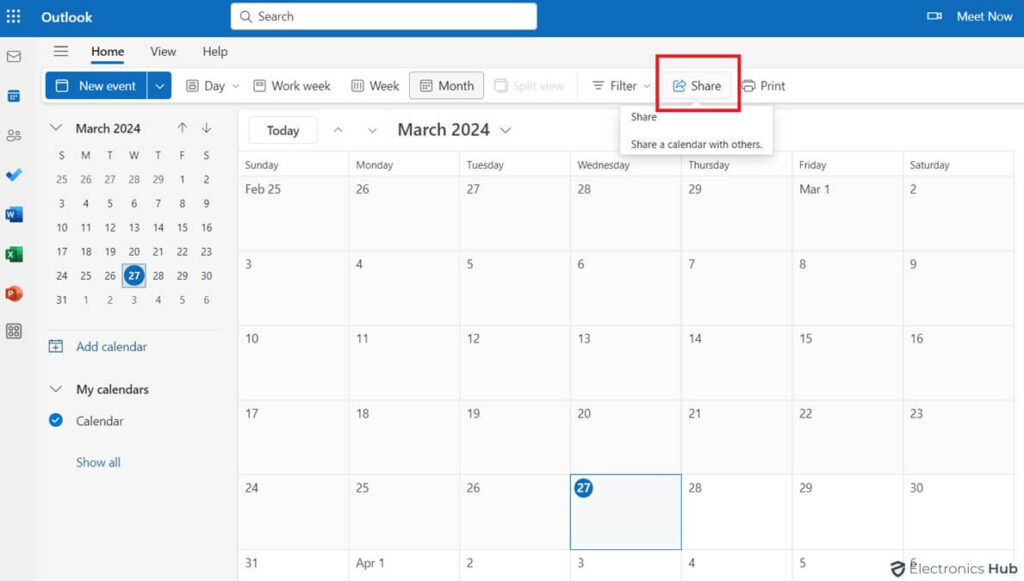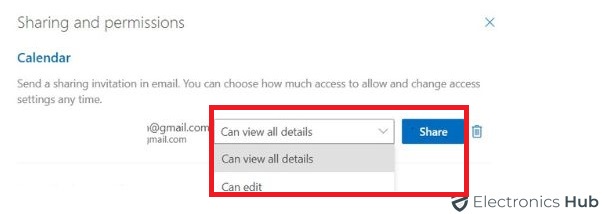As a busy professional, you must be organized and manage your time efficiently. Microsoft Outlook’s calendar feature might be quite handy in this regard. Outlook’s calendar lets you schedule appointments, set reminders, and track important events. Imagine a world in which your whole team is on the same page, literally! Outlook’s calendar-sharing function makes this possible. By sharing your calendar, you can keep coworkers informed about your schedule and avoid scheduling problems. This also fosters a more collaborative work environment.
Outline
Toggle- Why Calendar Sharing is Important?
- How to Share your Calendar in Outlook: Step-by-Step Guide
- How to Customize Sharing Permissions in Outlook?
- Advanced Sharing Features in Outlook
- Integrating Calendar Share with Other Outlook Tools and Features
- Tips for Effective Sharing in Outlook
- Best Practices for Effective Calendar Sharing
- Troubleshooting Common Issues with Calendar Sharing in Outlook
- Frequently Asked Questions
- Conclusion
Why Calendar Sharing is Important?
In today’s fast-paced professional setting, effective communication and scheduling are paramount. Here’s why calendar sharing works:
- Firstly, it simplifies the coordination and scheduling of meetings with colleagues or clients. Sharing your calendar helps people see your availability. And they can even see the right window without the need for many emails or phone calls. This saves valuable time and guarantees effective scheduling.
- Secondly, calendar sharing encourages more collaboration across teams or departments. Accessing one another’s calendars can easily detect overlapping obligations, plan projects more effectively, and ensure everyone is on the same page. This fosters better communication and collaboration.
- Finally, sharing your schedule with family or friends can help with personal life planning. Whether it’s arranging family events, planning social gatherings, or keeping track of school activities, sharing your calendar keeps everyone in the loop and prevents scheduling issues.
How to Share your Calendar in Outlook: Step-by-Step Guide
Sharing your calendar in Outlook is pretty simple. Follow these steps to start sharing your calendar:
1. Open Outlook and navigate to the calendar view.
2. Locate the “Share” button, which is often found in the toolbar or ribbon at the top of the screen.
3. When you click the “Share” button, a new window appears.
4. In the new window, enter the email addresses of the people you want to share your calendar with.
5. Choose the level of access you want to grant to each person. This can range from simply allowing them to view your calendar to giving them full editing rights.
6. If needed, include a note with extra information or directions.
7. Click on the “Send” button to share your calendar.
How to Customize Sharing Permissions in Outlook?
Outlook not only lets you decide who may see your calendar, but it also lets you customize specific permissions for each user. With this degree of control, you can be certain that you will always have the degree of privacy and security you desire. Below are some options for customizing calendar-sharing permissions:
- View-only access: This option allows others to view your calendar and appointment data, but they cannot alter or add new events.
- Limited access: With this permission level, people can view and edit your calendar but not delete any events.
- Full access: Granting full access gives others complete control over your calendar. They can view, edit, delete, and add events as they see fit.
- Delegate access: This permission level is ideal for assistants or team members who need to manage your calendar on your behalf. Delegates can create, modify, and delete appointments, as well as respond to meeting requests on your behalf.
Make sure each individual only has the right level of access by giving them thoughtful consideration when granting permissions.
Advanced Sharing Features in Outlook
Besides basic calendar-sharing functionality, Microsoft Outlook has additional features for improved collaboration and efficiency. Here are some important advanced calendar-sharing features:
- With ‘Resource Calendar’ you create and share calendars for shared resources like meeting spaces, equipment, or vehicles. This also ensures that everyone is aware of resource availability and can quickly book or reserve them.
- ‘Group Calendars’ allow many people to contribute and manage a single calendar. This is particularly helpful for project teams or committees who need to coordinate their schedules and tasks.
- Outlook lets you share your calendar with people outside your organization with the ‘External Sharing’ feature. This is useful for collaborating with clients, contractors, or partners who may need access to your schedule.
- The ‘Outlook Mobile App’ allows you to access and share your calendar while on the go. With this, you can stay connected and updated even while you are not at your desk.
Improve your Outlook calendar sharing, teamwork, and efficiency by making use of these advanced features.
Integrating Calendar Share with Other Outlook Tools and Features
You can further simplify your workflow by integrating Outlook’s advanced features and tools with calendar sharing. A few noteworthy integrations are as follows:
- Email Integration: By integrating your email and calendar, you can easily schedule meetings or appointments directly from your email client. This eliminates the need to switch between different applications and saves time.
- Reminders and Notifications: Outlook allows you to set reminders and receive notifications for upcoming events or deadlines. By integrating these features with calendar sharing, you can ensure that everyone involved stays informed and prepared.
- Task Management: You can easily integrate Outlook’s task management features with calendar sharing. Assigning tasks and deadlines through shared calendars ensures that everyone is aware of their responsibilities and can track progress.
- Meeting Scheduling: Using Outlook’s meeting scheduling assistant with calendar sharing helps you to find meeting times that work for everyone’s schedule. This eliminates the need for lengthy email threads and simplifies the scheduling process.
Tips for Effective Sharing in Outlook
Sharing your calendar properly can enhance productivity and teamwork. Here are some ideas to get the most out of calendar sharing in Outlook:
- Make sure everyone in your team or organization understands the goal and rules of calendar sharing. Get everyone on the same page about the usage and upkeep of calendars.
- Maintain a well-organized calendar by using color-coded categories, labels, and reminders. This makes it easier for others to understand and navigate your calendar.
- Make a habit of updating your calendar with accurate and current information regularly. This makes your calendar reliable for others to use when making appointments.
- When sharing your calendar, be mindful of personal or sensitive information. Double-check the permissions you grant to ensure that confidential events are protected.
- Only share your calendar with individuals who genuinely need access. This helps to minimize clutter and maintain focus.
By following these tips, you can maximize the benefits of calendar sharing in Outlook and optimize your workflow.
Best Practices for Effective Calendar Sharing
Calendar sharing is a must for efficient project management and teamwork in the workplace. Follow these guidelines for the most effective calendar sharing:
- Instead of relying on individual calendars, teams or departments may gain from having shared calendars. Due to this, everyone’s schedules can be seen and managed more effectively.
- Develop and communicate guidelines for using shared calendars within your organization. This avoids ambiguity and misuse of the feature while ensuring consistency.
- Insist everyone on the team maintains accurate and up-to-date schedules. This stimulates transparency and makes it easier for everyone to remember important dates and tasks.
- Assign specific colors to different types of events or projects. This facilitates a quick visual understanding of the schedules and tasks.
- You can see the schedules of all your team members in one place by using Outlook’s calendar overlay feature. This is particularly useful for visualizing project timelines and identifying potential conflicts.
Troubleshooting Common Issues with Calendar Sharing in Outlook
Of course, sharing calendars in Outlook is a great tool, but it also comes with limitations. The following are examples of common issues and how to fix them:
- If someone is unable to access your shared calendar, ensure that you have granted them the right permissions. Please be sure that the email address you provided is accurate.
- If your shared calendar does not show your changes, try synchronizing it manually or refreshing the page. Verify that Outlook is updated and your internet connection is stable if the problem continues.
- Occasionally, Outlook may experience technical glitches that can affect calendar sharing. In such cases, try restarting Outlook or clearing the cache to resolve the issue. If the problem persists, reach out to your IT support team for assistance.
If you run into any problems that you can’t seem to fix, don’t hesitate to contact your company’s IT department or the Outlook support staff for assistance.
Frequently Asked Questions
Ans: Yes, Outlook allows you to share your calendar with anyone who has an email address. However, it’s important to be mindful of privacy and only share with those who need access.
Ans: No worries! You can easily modify or revoke access permissions at any time through the “Share Calendar” settings.
Ans: While you can’t directly control others’ calendars, open communication is key. Discuss the importance of maintaining updated calendars for optimal shared visibility.
Ans: Microsoft offers a variety of resources and tutorials on its official website. You can also search online for helpful articles and video guides.
Conclusion
Calendar sharing in Outlook has many benefits, from streamlined scheduling to enhanced collaboration. By utilizing this powerful tool effectively, you can create a more efficient and productive work environment for yourself and your team as well. Remember, clear communication and respect for privacy are key to unlocking the full potential of shared calendars.
So, what are you waiting for? Start sharing your calendar in Outlook today and experience the power of collaborative scheduling!





